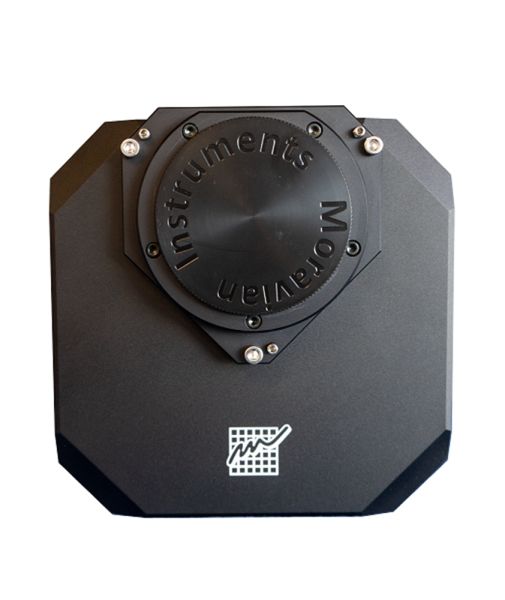Moravian C4-16000 Gsense 4040 CMOS camera
Moravian C4-16000 Gsense 4040 CMOS camera.
Sensor size 37×37 mm, 9 μm pixels and 16 MPx (4k×4k) resolution.
The C4-16000 cooled scientific CMOS camera sensors offer the same geometry like the CCDs in the famous G4-16000 cameras — sensor size 37×37 mm, 9 μm pixels and 16 MPx (4k×4k) resolution.
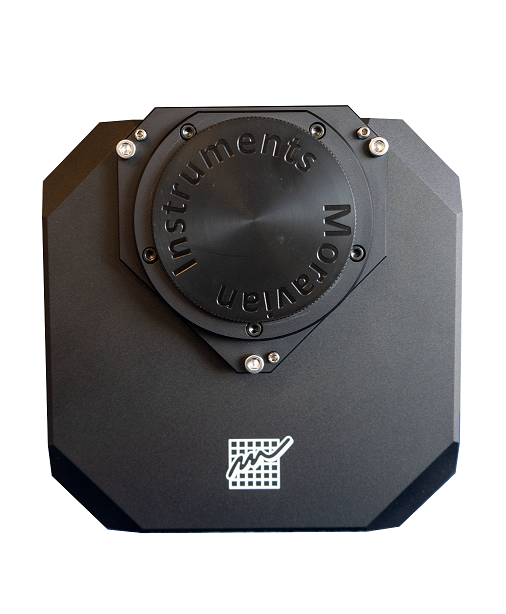
Also the mechanical design of C4 cameras inherits from G4 Mark II cameras, which makes the C4 camera line fully compatible with vast range of telescope adapters, off-axis guider adapters, filter wheels, Camera Ethernet adapters, guiding cameras etc.
Mechanical design of the C4 series of astronomical CMOS cameras inherits from earlier CCD-based G4 Mark II cameras, which makes the C4 camera line fully compatible with vast range of telescope adapters, off-axis guider adapters, filter wheels, Camera Ethernet adapters, guiding cameras etc.
Rich software and driver support allow usage of C4 camera without necessity to invest into any 3rd party software package thanks to included free SIPS software package. However, ASCOM (for Windows) and INDI (for Linux) drivers and Linux driver libraries are shipped with the camera, provide the way to integrate C4 camera with broad variety of camera control programs.
C4 cameras are equipped with Gpixel GSENSE4040 CMOS detectors with resolution 4096 × 4096 pixels. Pixel size is 9 × 9 μm, which leads to almost 37 × 37 mm light sensitive area.
The GSENSE4040 sensor is equipped with 12-bit ADCs (Analog to Digital Converters) only. However, there are two sets of ADCs inside the sensor, each capable to digitize the image with different gain — one set of ADCs uses low-gain channel, while the second set uses high-gain channel. Both 12-bit outputs of each ADC set can be combined to single image with true 16-bit dynamic range (such combined image is often called 16-bit HDR for High Dynamic Range).
Camera Electronics
CMOS camera electronics primary role, beside the sensor initialization and some auxiliary functions, is to transfer data from the CMOS detector to the host PC for storage and processing. So, as opposite to CCD cameras, CMOS camera design cannot influence number of important camera features, like the dynamic range (bit-depth of the digitized pixels).
Sensor linearity
The sensors used in C4 cameras show very good linearity in response to light. This means the camera can be used for advanced research projects, like the photometry of variable stars and transiting exoplanets etc.
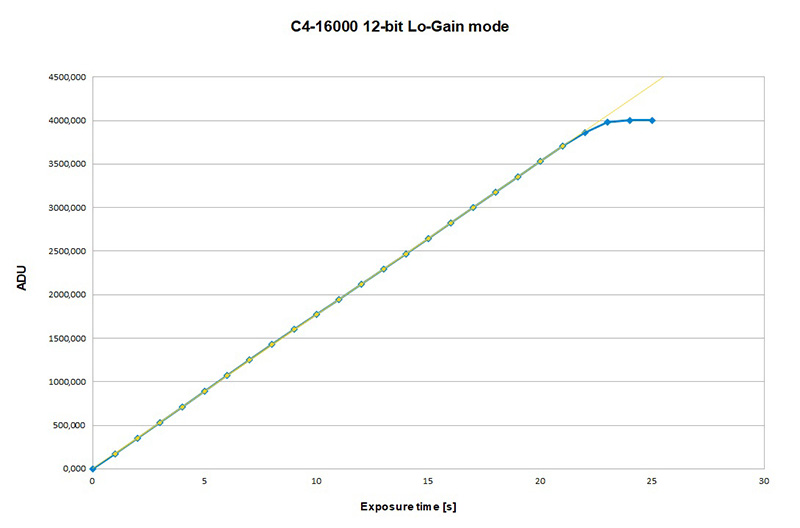
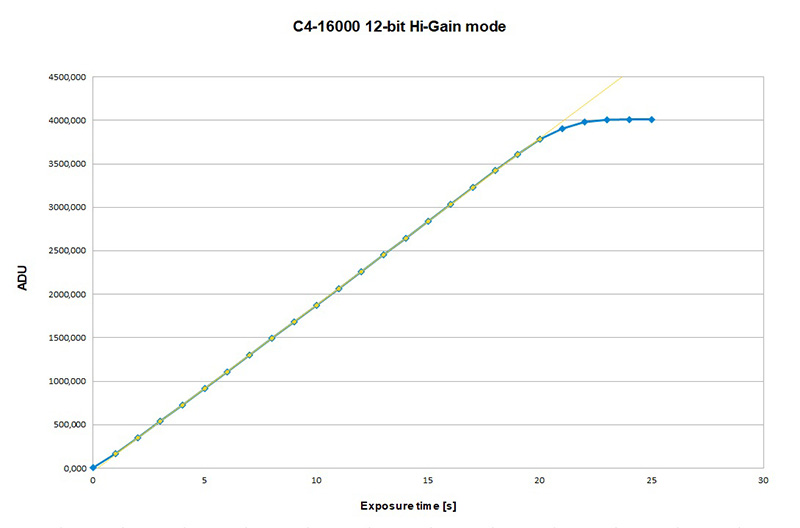
Combination of both low-gain and high-gain digitization channels into single 16-bit HDR image is designed to carefully preserve linear response to light. What's more, resulting 16-bit image does not combine full dynamic range of both low-gain and high-gain channels, but takes only the perfectly linear portions of both channels. So, the linearity of the resulting 16-bit image is perfect within the full dynamic range.
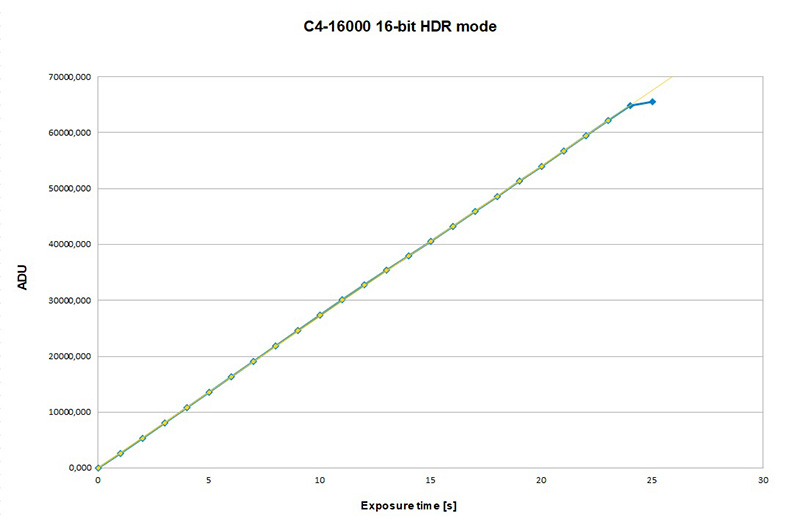
Download speed
C4 camera is equipped with on-board RAM, capable to hold multiple full-resolution frames. Downloading of the image to the host computer thus does not influence image digitization process, as the download only transfers already digitized images from camera memory.
Time needed to download single frame depends on the read mode and also whether fast USB3 or slower USB2 is used:
| Read Mode | 12-bit low/high gain | 16-bit HDR |
| USB 3.0 | 0.125 s | 0.250 s |
| USB 2.0 | 0.797 s | 1.578 s |
Conversion factors and read noise
C4 cameras do not offer the users to set gain, beside the two fixed low-gain and high-gain channels. 16-bit HDR image covers whole sensor dynamic range and manipulating with gain would bring no additional benefits.
| Read mode | 12-bit high-gain | 12-bit low-gain | 16-bit HDR |
| Full well capacity | 3,540 e- | 80,000 e- | 56,600 e- |
| Conversion factor | 0.85 e-/ADU | 19.5 e-/ADU | 0.85 e-/ADU |
| Read noise | 3.9 e- RMS | 34.5 e- RMS | 3.9 e- RMS |
Exposure control
C4 cameras are capable of very short exposures, the shortest exposure time is approx. 21 μs. However, the sensor employs so-called “rolling shutter”. This means the exposure does not start over the whole sensor at once, but exposure of subsequent lines begins with 21 μs delay and the whole sensor is illuminated 8.6 ms after exposure starts. Similarly, end of exposure and pixel digitization is performed line by line with the same delay between lines.
There is no practical limit on maximal exposure length, but in reality, the longest exposures are limited by saturation of the sensor either by incoming light or by dark current (see the following chapter about sensor cooling).
Sensor specifications and overscan area
C4-16000 cameras are supplied with Class 1 sensors. The light gathering area of the GSENSE4040 sensors is divided into 4 quadrants, slightly differing in bias levels. This division may remain visible as slightly different background levels, especially when the overall scene illumination is low. Such uneven background typically does not harm scientific measurements, as the differences are well beyond background noise. But aesthetic astro-photography can be negatively influenced if these differences are not removed during image processing.
Mechanical Specifications
Compact and robust camera head measures only 154 × 154 × 65 mm (approx. 6 × 6 × 2.6 inches) for the model with standard cooling. Enhanced cooling increases camera depth by 11 mm.
The head is CNC-machined from high-quality aluminum and black anodized. The head itself contains USB-B (device) connector and 12 V DC power plug, no other parts (CPU box, USB interface, etc.), except a “brick” power supply, are necessary. Another connector allows control of optional external filter wheel. Integrated mechanical shutter allows streak-free image readout, as well as automatic dark frame exposures, which are necessary for unattended, robotic setups.
| Internal mechanical shutter | Yes, blade shutter |
| Shortest exposure time | 21 μs (electronic shutter) |
| Longest exposure time | Limited by chip saturation only |
| Head dimensions | 154 mm × 154 mm × 65 mm (standard cooling) |
| 154 mm × 154 mm × 76 mm (enhanced cooling) | |
| Back focal distance | 33.5 mm (base of adjustable adapters) |
| Standard cooling head weight | 1.6 kg (without filter wheel) |
| 2.5 kg (with “M” external filter wheel) | |
| 2.8 kg (with “L” external filter wheel) | |
| Enhanced cooling head weight | 1.8 kg (without filter wheel) |
| 2.7 kg (with “M” external filter wheel) | |
| 3.0 kg (with “L” external filter wheel) |
| Product Status | New |
|---|---|
| Package width | 37 cm |
| Package height | 30 cm |
| Package depth | 20 cm |
| No. of parcels | 1 |




